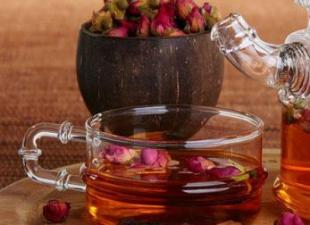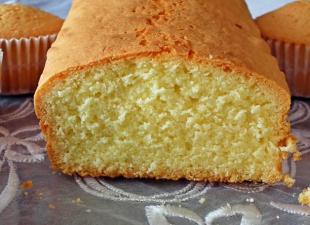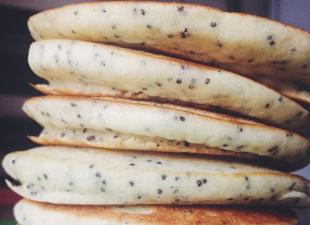Kort is a boiled cottage cheese of light brown color. It is used to prepare gubadya. It is not sold everywhere, so I decided to write how you can cook the court yourself. And you can do this in several ways. I found the recipes in the book of Tatar cuisine, I hope they will be useful to you.
It is best to cook the court in a thick-bottomed dish.
Kort from milk and katyk
Ingredients: 5 liters of milk, 0.5 liters of katyk and 200 gr. Sahara.
Boil milk. Pour katyk into milk, stirring constantly, continue boiling. After a while, you will see how cottage cheese forms in the dishes. Continue to boil until the curd turns reddish in color, add the sugar, stir and continue to boil again until all the liquid has boiled away. Transfer the finished court to another bowl, cool.
Fat-free cottage cheese court
Ingredients for 1 kg of court: fat-free cottage cheese - 1400 gr., sugar - 230 gr., milk - 500 gr.
Boil cottage cheese with milk until a reddish color forms. Add sugar. Use the cooled court to make gubadia or serve in bowls with butter.
Kefir court
Ingredients: 1.5 liters of kefir, sour cream or butter, sugar
Kefir put on a strong fire and boil until the liquid boils away. Then reduce the heat and continue to boil, stirring constantly. The mass acquires a yellow color, and as the moisture evaporates, the court remains in the form of grains of yellow color.
If you are preparing a court for Gubadya, you need to add sugar to taste, sour cream or butter, mix and hold on fire for a little more. You will get a thick homogeneous mass, which is well suited for the filling.
Kort from katyk
Ingredients: 1.5 liters of katyk, sour cream or butter, sugar
The method of preparation is exactly the same as from kefir. But the court from katyk, unlike kefir, is not at all crumbly, but viscous and in large pieces. Cool the finished court and pass through a meat grinder.
Court is an important part of my favorite pie. For sure lilmar already understood what kind of pie will be discussed soon, and the rest are scratching their heads over what this mysterious court is.
I probably already said, but I repeat once again, I really love Tatar pastries, they are completely unlike anything. As a child, a trip to the Tatar village was always a holiday for me, where the table was always bursting with an abundance of pastries, and so tasty that it was simply impossible to stop eating them!
And my "favorite" has always been gubadiya, this is the most unusual pie, there is no one similar to it in more than one cuisine of the world, but I will talk about it later, first you need to prepare the court.
Our court is sold in stores, but I was interested in making it myself.
In general, to be honest, I don’t know where else the court is used except in Gubadia, I dug around on the Internet - somewhere the court is called “Tatar cheese” (I have not heard this), butter and sugar are added to the dry court and served with tea.
In the book ("Tatar cuisine" Yu. A. Akhmetzyanov, 1985) it is advised to make kefir for Gubadia, so I started with kefir:
1 l. kefir (it was necessary to take fatter kefir, but I only found out at home that I grabbed fat-free kefir in the store)
30 g butter
75 g sugar
Everything is quite simple - pour kefir into a saucepan, put on a large fire, bring to a boil, reduce a little (so that it only boils slightly) and cook, stirring occasionally, until you get a court. It took me 1 hour 20 minutes and from 1 liter of kefir almost 150 g of court came out. As far as I understand, the court can still be boiled so that it becomes completely dry and then it can be stored for a very long time, and when needed, it can be soaked and used. But I was not going to store it, so I immediately added butter and sugar. There are no exact proportions in the book, I did it by eye.
As a result, the court turned out not the way I used to see it - the color is not so dark and the taste is too "kefir", and although the next day the taste became more like the taste of the court, the consistency was not the same. I blame the low fat content of kefir for everything.
The next day, I decided to make a katyk court (there is also such an option in the book):
1 l. katyka
20 g butter
50 g sugar
Cook in the same way as from kefir. I cooked it for 1.5 hours and from 1 liter of katyk I got a little more than 200 g of court. And the court turned out just the way it should be - tasty, crumbly, brown. I used it for Gubadia.


How to cook Gubadia - one of the types of traditional Tatar pastries? First you need to make a special filling. Gubadia with a court suggests that inside the dough base there will be a special kind of cottage cheese. It must be prepared by hand. This is what we will do first. The second step is to create such a delicacy as gubadia with a court.
Court Recipe
It is this important component of a delicious pie that you will need to cook at home. Gubadia with a court, the recipe of which we want to describe in detail here, is a very special one. Ordinary white cottage cheese is not suitable for it. We need red, also called a court (or kurut). It can be made from kefir. This product is very tasty. It can be cooked more (for Gubadia, it will take a little more than two hundred grams) and served with tea with butter and cheese. To get started, take fatty kefir or fermented baked milk. You can do it with fat-free, but in this case you will have to add more butter. For a standard portion of the court, a liter of kefir, 30 g of butter (without vegetable fat impurities) and three tablespoons of sugar are enough.

Pour the liquid into a saucepan, put on a large fire and, bringing to a boil, cook until the whey boils away. This will take about an hour and a half. Don't forget to stir. You will get a dry product of a dark red or brown hue with a unique taste. The nomads dried the court in the sun, rolling it into small balls. It became hard and suitable for long-term storage. We do not need to do this (unless you also want to cook several portions of the court at once - in this case, dry it on the stove, and soak it before use). You can make red cottage cheese from katyk.
Gubadia with a court: recipe
This pie is a multi-layered holiday pastry that came from its traditional varieties, which are baked not only with fruits (dried fruits), but also with meat. For sweet, raisins are most often used. In addition to it and the court, there are two more obligatory fillings in the pie - eggs and sweet rice. The latter must be pre-cooked in the way you usually do. To make a real gubadia with a court, the recipe recommends adding as much butter as possible to the dough.

The very same it can be both unleavened and yeast. For example, for fresh, mix half a glass of warm milk with three pinches of sugar, an egg, half a pack of melted and cooled butter. Salt. Add 2.5 cups of flour, knead the dough. Devide into two parts. Boil one and a half cups of dry rice and 5 chicken eggs. Finely chop the eggs. Pour raisins (125 g) with boiling water or (you can add a spoonful of alcohol when soaking), leave for a while. In addition, another half a pack of butter is useful. It needs to be melted down. For sprinkling, make an ordinary streusel - rub flour, sugar and butter with your hands. A small crumb should form. Put the first layer of dough in the form, then lay out the fillings one by one - rice, court, more rice, eggs, the last layer of rice, then raisins. Drizzle all layers on top with oil. Cover with a second layer. Pinch the edges, bake for a little over an hour.
Tatar and Bashkir traditional cuisine is famous for its delicious pastries. The famous gubadia - decorates the table in every family for a big holiday. No wedding is complete without this cake. It has many options, but there is a mandatory set of products and cooking rules that everyone follows:
- There is a lot of oil in the dough (fresh or yeast).
- The filling is laid in layers, without mixing.
- The obligatory ingredient of the filling is cort (dry cottage cheese).
- Eggs, rice, some dried fruits are always put in it.
There are two types of gubadia: sweet - a dessert for tea, and meat - a hot second, which is made with fried minced meat laid on top of dry cottage cheese, or without a court at all. We are making sweets.
How to cook a court
Kort is made by removing moisture from a fermented milk product, evaporating it or leaving it to drain, then dry it in an oven, and in hot countries in the sun. Sometimes a little salty. For gubadia, it is crushed to a state of powder, steamed, dipped in hot milk, mixed with butter (only butter) and sugar.
Ingredients:
- three half-liter packs of kefir (yogurt can be used);
- 4 tbsp. spoons (necessarily with a slide) of sugar;
- 1 st. a spoon (also with a slide) of butter (only ghee is suitable).
We prepare the court in a large bowl: boil kefir for about an hour. The moisture should boil away - the resulting cottage cheese will be beige.

Pour, stirring, sugar - let the mixture still boil, so that the liquid evaporates completely, the sugar dissolves.

Remove the pan from the stove, put the oil, stir thoroughly. It turns out about 400 g of court

Cooking yeast dough
Ingredients:
- a large glass of flour;
- a quarter of such a glass of milk;
- 1 teaspoon (full) of sugar;
- egg;
- pressed yeast - 8 g;
- a pinch of salt;
- 2 tbsp. spoons (full, even with the top) of ghee.
Slightly warm the milk, dilute the yeast in it and put it in a mixture of flour, eggs and sugar. The well-kneaded dough should come up warm and double in size.
We introduce salt and oil into the dough (in small portions, having previously melted). We continue to stir. You can not add oil, but, dipping your hands into it, knead the dough until all the oil goes into it. It turns out a small lump of dough, smooth and elastic, which should still rise.

Cooking stuffing
Ingredients:
- 125g bag of rice (dry);
- 4 eggs;
- a couple of handfuls of raisins;
- 400 g of court;
- 2 tbsp. tablespoons of melted butter (take with a slide).
Cook rice - it should be completely ready. Hard-boiled eggs, cut into small pieces. We leave the raisins to swell in boiling water.
Gubad assembly
We separate a third of the dough for the lid of the pie. We roll out the main part and put it on a greased pan with a good approach to the edges. We lay the filling, slightly pressing each layer. Pour boiled rice (about half).

We put the reconciliation on the court.

Above it are eggs.

Lay down the second layer of rice.

Then swollen and slightly squeezed raisins.

For even impregnation of the filling, pour it with hot oil.

From the second piece of dough, roll out the lid, put it on the top layer, carefully pinch the edges.

Before being sent to the oven, the gubadiya must be separated - we give it 20 minutes for this and make flour crumbs for sprinkling, introducing softened butter into the flour in a ratio of 2: 1 (for example, 100 and 50). Grind the mixture with powdered sugar (you need at least a tablespoon) with your hands into crumbs.

Lubricate the lid with the remnants of melted butter, properly sprinkle the entire surface with crumbs.

We bake in a preheated oven, setting it at 180 °, for at least 40 minutes.

Gubadia is served hot, although it is delicious cold.
 karaoke-k3.ru Pancakes, pancakes, buns, muffins, dumplings, pies, cookies, cakes, khachapuri.
karaoke-k3.ru Pancakes, pancakes, buns, muffins, dumplings, pies, cookies, cakes, khachapuri.


